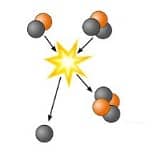The first step we are going to take before delving fully into the meaning of the term nuclear fusion is to discover the etymological origin of the two words that give it shape:
-First of all, fusion is a term that derives from Latin, specifically from "fusio", which can be translated as "action and effect of melting." It is the result of the sum of two lexical components of said language: the verbal form "supum", which derives from the verb "fundere" (to melt), and the suffix "-sion", which is used to indicate "action and effect."
-Nuclear, on the other hand, also derives from Latin and is the result of the union of these two components: the noun "nucleus", which can be translated as "nucleus" or "center", and the suffix "-ar", which It is used to indicate "relative to."
In its broadest sense, a merger is the union or integration of two or more elements. Nuclear , for its part, is that linked to a nucleus : the central, essential or internal part of something.
 The idea of nuclear fusion appears in the field of physics . This is the name given to the reaction that occurs when two light atomic nuclei join together, generating a heavier nucleus and releasing a large amount of energy .
The idea of nuclear fusion appears in the field of physics . This is the name given to the reaction that occurs when two light atomic nuclei join together, generating a heavier nucleus and releasing a large amount of energy .
Nuclear fusion, therefore, involves the union of different atomic nuclei that have a similar charge. The result of the process is the formation of a heavier nucleus and the release of energy . This particularity makes nuclear fusion a reaction that can be caused by humans in certain areas with the aim of generating energy (in this case, nuclear energy ).
It is important not to confuse nuclear fusion with nuclear fission . While in fusion two or more light nuclei join together, in fission the breakage of a heavy nucleus occurs through bombardment with neutrons. Both fusion and fission cause the release of energy.
Nuclear fusion occurs naturally in stars . Solar energy , in fact, is generated from the nuclear fusion of hydrogen found in the most important star in the solar system: the Sun.
Regarding nuclear fusion, it should be noted that it has its advantages and also its disadvantages. Specifically, regarding the pros, it must be emphasized that there is the fact that it is an inexhaustible source of energy, since Deuterium is really abundant in the environment, and that it is a clean energy, since it does not bring with it any type of gases. harmful. Likewise, it is also an advantage that a reactor generated by it is extremely safe.
On the contrary, among its drawbacks are that it is still really difficult to reach the ignition state and that it is a proposal that still requires a lot of research.
The so-called hydrogen bomb or H-bomb is a weapon of mass destruction whose energy is obtained from the fusion of tritium and deuterium nuclei (both isotopes of hydrogen ), which produce a helium nucleus. The first bomb of this type, developed by the United States and named Ivy Mike , was detonated in October 1952 on Enewetak Atoll, belonging to the Marshall Islands .
